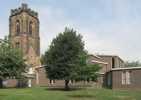 Eastwood Eastwood
St Mary
Clock
The clock was installed in the tower of the church in 1866, and this was made
possible by the proceeds of sums of money donated by ‘Public Subscribers’.
The Clock faces are of stone with five feet diameter dials and are positioned
on the North, South and West faces of the tower.
The Account Book records a list of the 106 benefactors, together with their
donations varying from 6d to £20. Mr W S Smith was paid £28 10s
for altering the chimes.
| Sept 3rd |
Paid to Messrs Cope for making and fixing
Clock in Tower as per Contract |
£140 0s 0d |
| Sept 3rd |
Paid for altering Chimes as per agreement |
£25 0s 0d |
| Sept 3rd |
Paid Mr James Shaw for Woodwork as per Bill |
£3 10s 0d |
| Sept 3rd |
Paid Incidental expenses |
10s |
| |
Total Cost |
£169 0s 0d |
According to the accounts of 16 December 1865, Mr William Newton was paid
2s 6d for cutting a doorway into the clock case, indicating that installation
was then in progress.
The original public clock, like others of its type, needed winding, and care
and maintenance if they were to keep correct time. Mr James Shaw appears to
have been the first to be employed on winding the clock, at a salary of £5
per year. It was not until 1906 that the salary was increased to £7 10s,
paid to Mr E Lynam, who was well known locally as a watch and clock specialist.
It was further increased in 1914, to £10, and remained so for many years.
At £10 the salary was well earned, bearing in mind the long climb up
the tower staircase and a ladder to the clock chamber, winding the clock, and
the long descent to ground level once a week throughout the year, averaging
a little less than 20p per week.
The original manually wound clock movement was replaced in 1966 by a Syncro
Hour Strike electrically driven movement (T1 Syncro & H1 Hour Strike) supplied
and fitted by John Smith and Sons of Derby and cost £680.
|